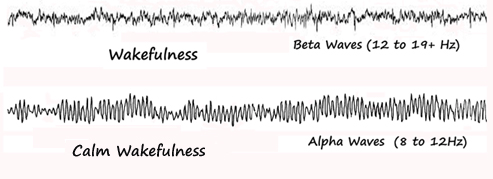How Sleep Works
A Guided Tour
Falling Asleep
Imagine yourself on a typical night at home. It’s about an hour and a half before you usually turn in. And even though you’re not really thinking about sleep at this point, your body is already preparing itself for bedtime.
Deep in the center of your brain, a tiny pea-sized, pinecone-shaped endocrine gland called the pineal gland, has responded to the darkness outside by releasing melatonin into your bloodstream. Melatonin is a hormone that drives your body’s circadian rhythm — the internal biological rhythm that keeps you in sync with the 24-hour cycle of night and day. As the melatonin flows through you, it signals every part of your body to start shifting out of the active state and wind down. Your metabolism begins to decrease and your core body temperature drops, with the drop becoming more rapid in the last hour before bed.
A little later, you begin to feel a more obvious effect: you get sleepy. By the time you’re getting ready for bed, standing in front of the bathroom mirror brushing your teeth, you feel good and tired. Glad to call it a day.
As you settle into bed and turn out the light, you begin to relax and feel calm. You let your eyes close and soon you can feel your breathing slow down and the muscles throughout your body gently letting go. Your mind starts to drift freely. You are now entering a pre-sleep state known as calm wakefulness.
During the day, your brain waves are made up of beta waves — these are high-frequency, low-amplitude waves (12 to 19+ Hz) that characterize the active, wakeful state. Now that you’re getting drowsy, these waves are replaced by ones of a lower frequency and slightly higher amplitude, called alpha waves (8 to 12 Hz). Alpha waves are sometimes associated with the mental state reached in meditation.

Your body takes on a rather pleasant sensation of heaviness now, as if your limbs had become distant and somewhat disconnected from the rest of you. At the same time, your mind feels wonderfully unconstrained, able to stretch out and reach into infinite space. Your thoughts seem to take on a life of their own as the world around you loses its solidity and fades away. And like thread going through the eye of a needle, you feel yourself drawn into sleep. See you on the other side…
Stage 1: Drowsy Sleep
You are cocooned in a beautiful, womb-like silence. A kind of veil has dropped over your senses, filtering out most perception of your surrounding environment. Your conscious mind has disengaged itself from the waking world. Are you asleep? It might be more accurate to say that you’re no longer awake. Stage 1 is a kind of transition phase between wakefulness and true, solid sleep — something like what we mean when we say “half-asleep.” Think of stage 1 as the evening twilight that lingers after the sun goes over the horizon.
If we check out your brain waves now, we’ll see that the alpha waves of calm wakefulness are tapering off, replaced by a lower frequency wave pattern called theta waves (4 to 8 Hz). It means you’re drifting along nicely through stage 1 of NREM.

You’re still very much on the knife’s edge between wakefulness and sleep and could go either way. Any sudden, unfamiliar noise or just a tap on the shoulder could bring you right back. But if someone whispered your name, you most likely would not hear it. The sleep of stage 1 is so shallow that when you wake someone out of it, they’ll almost always deny ever having been asleep!
Your eyes are making slow rolling, back-and-forth motions under the lids.* Your breathing is fairly deep and regular. The muscles throughout your body go slack as you give yourself over to sleep.
Sometimes as this happens, your body reacts with a hypnic jerk or “sleep start,” a small, involuntary twitch felt in the arms or legs. Every once in a while this will startle you back into a brief wakefulness, but most of the time you won’t even notice it.
We’re said to do a certain amount of drifting in and out as we fall asleep, oscillating for a few enigmatic moments between arousal and sleep. Most of the time, your descent is rapid enough that it all goes unremembered. But occasionally we are suspended at the edge of slumber long enough that we may experience a dreaming, altered state of consciousness known as hypnagogia.
Hypnagogic, or sleep-onset dreams, are quite different from the kind of dreaming we do when we’re fully asleep — they’re really more like fragments of a dream or “dreamlets.” They have a bizarre way of mixing dreams with consciousness, giving them an almost hallucinatory quality: You see fleeting images and kaleidoscopic patterns of color that seem to dance on the inside of your eyelids; you hear things that aren’t really there like the phone ringing or someone calling your name; your thoughts shuffle themselves into strange jumbles of words and kooky, disjointed phrases; some people experience an out-of-body-like sensation of floating.
By now you’ve been drowsing along through stage 1 for about five minutes, journeying across the borderland that lies between wakefulness and continuous sleep. And you’ve just about made it through. In just a moment you will settle into a deeper form of sleep as you enter the second stage of Non-REM.
*Note: This is not to be confused with the rapid eye movement of REM sleep.
